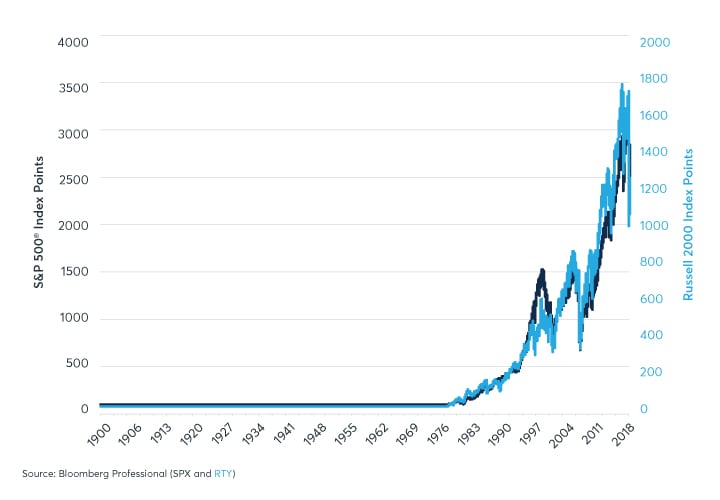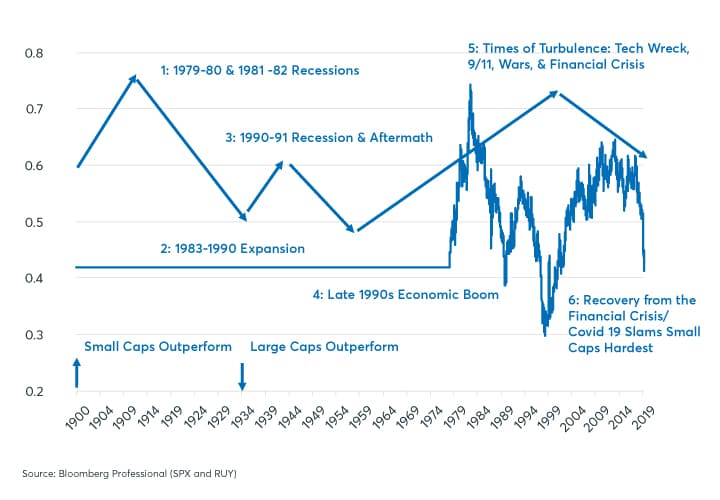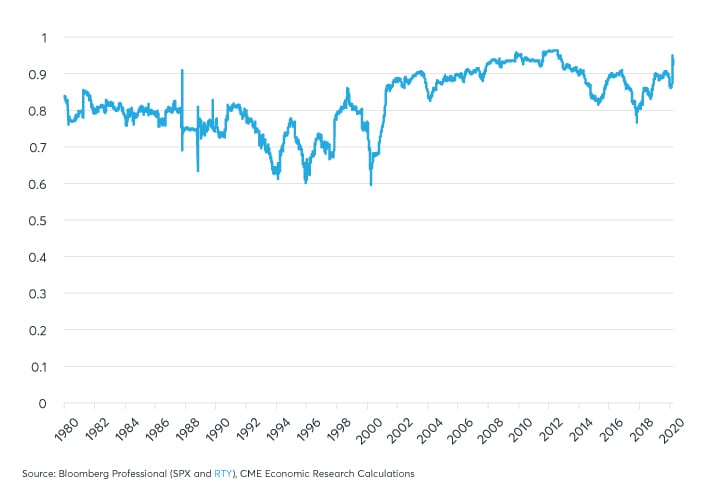By Erik Norland
The Russell 2000, a measure of small-cap US stocks in the Russell 3000 index, often outperforms the large-cap S&P 500 during times of economic turbulence.
Since the Russell 2000® began tracking the performance of small-cap stocks in 1979, the stock index has broadly matched, if not slightly exceeded, the performance of the venerable S&P 500® index of large-cap stocks (Figure 1).
While the two stock indexes’ overall performance has been similar and their correlation generally high (0.8 on average; ranging from 0.6 to 0.96 on a one-year rolling basis), they have diverged significantly at times. (Figure 2).
About the indices
The Russell 2000 Index, from index provider FTSE Russell, is the recognized benchmark measuring the performance of the small-cap stock segment of the US equity universe. The Russell 2000 Index is a subset of the Russell 3000® Index, representing approximately 10% of the total market capitalization of that index. Learn about Russell 2000 futures and options at CME Group.
The S&P 500 Index, from index provider S&P Dow Jones Indices, is a stock market index that measures the stock performance of 500 large companies listed on stock exchanges in the United States. It is one of the most followed equity indices, viewed by many as the leading barometer of the US stock market. Learn about S&P 500 futures and options at CME Group.
Figure 1: 38 Years of Small-Cap-Versus-Large-Cap Performance.
Historical performance - S&P 500 and Russell 2000 prices
- 1979-1983: the Russell 2000 outperformed the S&P 500 by 80% during a period of extreme economic turbulence in the stock market, with double-digit inflation, double-digit interest rates and back-to-back recessions in January-June 1980 and August 1981-December 1982. At the time, investors judged that smaller companies navigated the environment more nimbly than larger ones.
- 1983-1990: during the long economic expansion in the 1980s, large caps rebounded, leaving small caps in the dust. During this period of increased economic certainty, the S&P 500 outperformed the Russell 2000 by 91%, more than recovering its 1979-83 period of underperformance.
- 1990-1994: during the 1990-91 recession and its immediate aftermath, small caps again outperformed the S&P 500 by nearly 50%.
- 1994-1999: during the strongest phase of the 1990s expansion, the S&P 500 large caps again outperformed the Russell 2000 small caps just as they had during the 1980s boom. This time the S&P 500 outperformed the Russell 2000 by 93% over five years.
- 1999-2014: in a new era of turbulence (tech wreck, 9/11, Afghanistan and Iraq wars, subprime bubble, economic meltdown and quantitative easing, small caps swiftly outperformed large caps once again, with the Russell 2000 drubbing the S&P 500 by 114%.
- Since 2014: large cap stocks generally outperformed during the later stages of the 2010s expansion, much as they had during the later stages of expansion during the 1980s and 1990s and even as they did during the final stages of the 2003-2007 period of growth. Much of the recent outperformance of large caps has to do with their larger weighting to technology stocks and the spectacular performance of a handful of the very largest tech firms. The Covid-19 pandemic hit small caps especially hard. Few among them are online delivery services or other entities that have proven to be relatively insulated from the crisis. Small caps stocks have shown a much stronger reaction to news regarding lockdowns or the possible lifting of lockdowns that have large caps. Since early 2014, the S&P 500 has outperformed Russell 2000 by 56% as of mid-April 2020.
Figure 2 - Small-Cap Outperformance and Underperformance Since 1979.
Historical performance - Russell 2000 / S&P 500 ratio
Despite the evolution in the ratio between small and large cap stocks over time over time, the daily correlation of the indices remains extremely high, especially during periods of stress (Figure 3). The fact of a high correlation between small caps and large caps is probably a little frustrating to long-only investment managers as it limits diversification benefits. By contrast, for long/short managers, the strong correlation opens up possibilities to take advantage of the strong trends in the relative performance of the two indexes – and significant risks, as well, if they are caught on the wrong side of the trade.
Figure 3: Highly-Positive and Reasonably Stable Historical Correlations.
Historical performance - S&P 500 vs. Russell 2000 1Y rolling correlation
Since 2000, realized volatility has been higher for small cap stocks than it has been for large cap stocks, although this was not the case prior to the year 2000 (Figure 4).
Figure 4: Smalls Caps Have Been Riskier than Large Caps Since 2000 (but not Pre-2000).
Historical performance – One-year rolling annualized risk (standard deviation)
The key question for small cap stocks is, relative to large caps, will they more successfully adapt to rapid changes in economic conditions in 2020s? During past periods of economic distress (1979-82, the early 1990s, the early 2000s and the global financial crisis and immediate aftermath), small caps outperformed. This time, will they be able to overcome or adapt to the competitive advantages of the largest online delivery, software, social networking and technology equipment makers? The answer to these questions may depend on the course of the pandemic and what the world looks like when the pandemic eventually subsides.
Bottom line:
- Although the Russell 2000 and S&P 500 usually exhibit a high correlation, they can have periods of significant outperformance/underperformance relative to one another.
- Small caps have typically outperformed large caps during period of economic turbulence (1979-83, 1990-94 and 1999-2014).
- Large caps often outperform in the later stages of bull markets and during the strong phases of economic expansion.
- Since 2014, the S&P 500 has been rebounding versus Russell 2000.
- Small cap stocks have been especially hard-hit during the pandemic.
- Russell 2000 has a lower weighting to technology stocks than does the S&P 500.
Related questions
1. How can a trader take a position on the performance of the Russell 2000 versus the S&P 500?
Spread trading with futures is a technique that can be used to take advantage of price discrepancies and involves simultaneously going long and short futures contracts with the hopes that the profits on one leg of the spread are greater than the losses on the other leg of the spread.
A trader with an opinion on small-cap stock performance compared to large-cap stock performance could use futures on the Russell 2000 and S&P 500 indices, to initiate an inter-market spread trade to represent his/her opinion.
Learn more about inter-market spreads here.
2. What are the key differences between Russell 2000 futures versus ETFs on the Russell 2000 (IWM) on cost efficiency?
Given the diversity of clients and the many potential uses for both futures and ETFs, there is no one-size-fits-all answer to the question of whether futures or ETFs on the Russell 2000 will be the more cost-effective instrument to trade.
Answers will depend upon factors such as commissions, implementation cost, as well as the holding period or the trading strategy employed while focusing only on the total cost analysis, This sets aside other attributes such as liquidity, nearly 24-hour access and capital efficiencies that make futures an appealing alternative.
Learn more in our CME Institute course.
To learn more about futures and options, go to Benzinga’s futures and options education resource.
© 2025 Benzinga.com. Benzinga does not provide investment advice. All rights reserved.
Trade confidently with insights and alerts from analyst ratings, free reports and breaking news that affects the stocks you care about.



